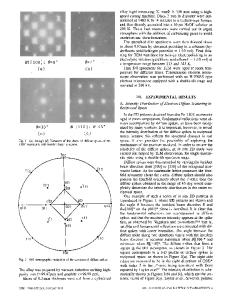Transmission electron microscopy of C 70 single crystals at room temperature
- PDF / 1,263,763 Bytes
- 7 Pages / 576 x 792 pts Page_size
- 26 Downloads / 404 Views
Shengzhong Liu and Manfred M. Kappes Department of Chemistry, Northwestern University, Evanston, Illinois 60208 (Received 19 February 1992; accepted 8 May 1992)
Transmission electron microscopy (TEM) techniques have been employed to study the room temperature solid state form of chromatographically purified C70. Tilting and electron diffraction experiments in three-dimensional reciprocal space, on samples prepared by crystallization from several different solvents, show that C70 crystallites adopt hexagonal close packed (hep) structure with a = 1.01 ± 0.05 nm and c = 1.70 ± 0.08 nm. The extinctions and observed reflections conform to the P6 3 /mmc space group. High resolution TEM images reveal the molecular order and periodicity associated with C70 crystallites in real space. The experimental results are in agreement with the preliminary computations of crystal structure within acceptable error limits. I. INTRODUCTION The recently discovered large-scale synthesis and separation method for fullerenes1^ has led to intense research activity to fathom the details of their molecular, crystal, and electronic structure. As a result, C60 is now comparatively well characterized and understood.5"7 However, there are less data pertaining to C 70 , the next most abundant fullerene and first cousin of C6oTheoretical treatments of the C70 molecular structure8 backed by an x-ray single crystal diffraction study9 of (i72-C70)Ir(CO)Cl(PPh3)2, an organometallic derivative, conclude that C70 has a truncated rugby-ball shape and compared to C6o an extra belt of nearly hexagonal carbon rings. There is as yet no x-ray single crystal structure for the underivatized molecule and here 2-D 13C-NMR experiments10 are the most persuasive structurally, providing connectivities which conform to the proposed D5h geometry. This can in turn be approximated by a spheroid with short and long axis dimensions of ds — 0.72 and di = 0.85 nm, respectively.8 As part of a preliminary study we reported that C70 crystallites prepared from toluene solution adopt a hexagonal close packed (hep) lattice with a = 1.01 nm, c = 1.68 nm (within 5% error), and P6i/mmc space group.11 A more recent study12 of solvent-free C70 has reported the observation of "primarily face-centered cubic (fee) material with some admixture of hep C70 (a = 1.056 nm; c — 1.735 nm)." In that study, samples crystallized from toluene solution and retaining appreciable solvent were found to form only hep crystallites, having marginally larger lattice constants than found for the solvent-free hep phase. In this communication we present and analyze, in detail, additional single crystal electron diffraction 2440
J. Mater. Res., Vol. 7, No. 9, Sep 1992
measurements obtained for high purity C7() samples crystallized from several different solvents. Within the constraints of the limited statistics associated with this type of measurement, hep crystallites were observed throughout. Real space HRTEM images of C70 crystallites are presented that appear to show the details of molecular packing within
Data Loading...











